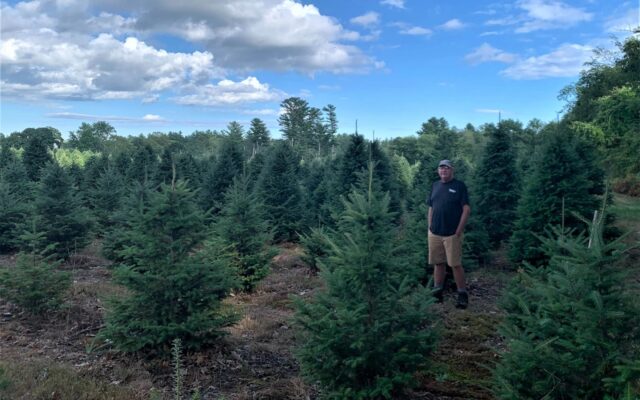
With 3rd dry summer in a row, more Maine farmers are exploring irrigation
By Nicole Ogrysko, Maine Public
Bob Bragdon had high hopes for the season, because he used a new planting technique this year to drop Christmas tree seedlings into the ground on his farm in Wells.
But this summer’s drought has not been kind to those young trees.
Bragdon planted about 1,500 Canaan fir seedlings this spring and thinks he’s lost about half of them to drought.
“This tree, it may be dead, it may not be,” Bragdon said, pointing to a short brown shrub poking out of the ground. “We won’t know until next spring.”
In the meantime, Bragdon is thinking ahead. A friend with a Christmas tree farm in Dayton is using a tractor to pump water from a newly dug well to irrigate his trees, he said. Bragdon is considering a similar arrangement and is weighing the potential cost.
“Maybe $5,000 to dig a well, I’m guessing. Probably another $5,000 for the equipment,” he said. “I have the tractors, so we’ll see. It beats losing $3,000 worth of trees every year.”
Climate researchers say that Maine is expected to experience an increase in precipitation in the coming years. But for the last three summers, farmers across Maine have been grappling with localized drought. Nearly all of Maine’s counties were experiencing severe, moderate or abnormally dry conditions in early August. Recent showers have helped somewhat, though parts of coastal Cumberland County up to Penobscot Bay remain in a severe drought.
The situation has prompted some farmers to seek help in replacing or installing new irrigation systems — and for those who haven’t, it may just be a matter of time.
Bragdon’s concern has been a familiar one for many farmers in southern and coastal Maine this summer, said Luis Aponte, the district conservationist for York and Cumberland Counties for U.S. Department of Agriculture’s Natural Resources Conservation Service.
“It’s been rough out there for them, because they are deciding what to irrigate and what to put at risk of having losses,” he said.
At Aponte’s office, applications for irrigation assistance have doubled this summer compared with last year, a trend that he expects will continue as drought becomes more prevalent in Maine.
“There will be an increased need,” Aponte said. “I’m sure that we will be obligating more funds for irrigation because of that.”
Aponte’s office was able to assist Caitlin Jordan and her father with new irrigation equipment this year. In the past, the brook on their family farm in Cape Elizabeth had always provided enough water to irrigate their produce. But the water had become too low in recent years, and they were forced to buy a $35,000 tap to connect with the Portland Water District.
Jordan said she won’t know how much water she’s used this summer, until she receives her first bill at the end of the season.
“Even if they told me that I’ve used X amount and it’s going to cost thousands of dollars, I still need to continue to grow vegetables, or I won’t have anything to pay the bill,” she said.
Farmers farther north are expressing a similar interest in irrigation as well.
“We have been getting more calls for irrigation and for organic farming,” said Toby Hall, a fifth generation farmer in Sangerville, who also sits on the board of the Piscataquis County Soil and Water Conservation District.
Hall’s family also owns a Christmas tree farm, but unlike Bob Bragdon in Wells, his trees are doing well despite the dry conditions.
Hall said board members are hearing from farmers who want to know more about building high-tunnel greenhouses and using organic farming practices to keep more moisture in the soil.
Hall himself decided to have an irrigation pond built on his own property two months ago, which is being used by another farmer to grow produce.
“We also knew it would be a gamble,” he said. “Would it hold water? And would he be able to pull water out of there and irrigate, and how many times could he do it?”
As it turned out, the pond was used seven times within a two month period.
This article appears through a media partnership with Maine Public.